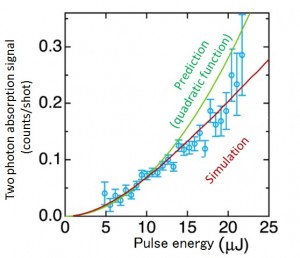The first observation of two-photon absorption in hard X-ray region Almost-simultaneous double shot at atom in hundreds of zeptoseconds

When we perceive color through our eyes, it is the result of light being absorbed by a material. This process usually takes place when a single light particle (photon) is absorbed by a single atom and can occur in not just the visible spectrum but in the X-ray region of the spectrum as well. However, if you make the X-rays incredibly strong, that is, if you can confine a very large amount of X-ray photons in a very small volume, by applying those X-ray photons to a single atom in the extremely short time of several hundred zeptoseconds (1 zeptosecond is 10-21 seconds), it is possible to have a single atom absorb two separate photons at almost the same time. However, it was thought that this was very difficult to realize experimentally because the probability of X-ray two-photon absorption is an order of magnitude lower than that of visible light.

© Kenji Tamasaku (RIKEN). The difference between experimental value (blue) and prediction (green) by a quadratic function increases with the increase of X-ray pulse energy. The simulation (red) taking into account the destruction process of the sample can predict the experimental results.
Associate Professor Hidekazu Mimura at the University of Tokyo Graduate School of Engineering Department of Precision Engineering, Dr. Kenji Tamasaku and Group Director Makina Yabashi at RIKEN, Associate Professor Eiji Shigemasa at the Institute for Molecular Science Ultra Violet Synchrotron Orbital Radiation Facility (UVSOR), Professor Kazuto Yamauchi at Osaka University Graduate School of Engineering, and Dr. Haruhiko Ohashi at the Japan Synchrotron Radiation Research Institute (JASRI) and their colleagues successfully observed two-photon absorption of X-ray by germanium at the SPring-8 Angstrom Compact Free Electron Laser (SACLA).
Using the X-ray Free Electron Laser (XFEL) developed jointly by RIKEN and JASRI, the first such facility in Japan, the group developed a focusing system with a focal size of about 100nm. By illuminating a germanium sample with this intense XFEL beam, the group realized two-photon absorption for the first time. Concurrently, the research group showed that the sample illuminated by intense X-rays is destroyed on a femtosecond scale (one femtosecond is 10-15 seconds). Finally, the research group successfully determined information about the nature of the sample before destruction by combining computer simulation of the process of destruction with measured data.
The result is not only an important step in advancement of X-ray nonlinear optics, but as a method of obtaining information about a sample prior to destruction by intense X-rays, this research has significance for a broad range of XFEL applications including crystal structure analysis of small samples of protein crystals and microscopy.
Paper
Kenji Tamasaku, Eiji Shigemasa, Yuichi Inubushi, Tetsuo Katayama, Kei Sawada, Hirokatsu Yumoto, Haruhiko Ohashi, Hidekazu Mimura, Makina Yabashi, Kazuto Yamauchi, Tetsuya Ishikawa,
“X-ray two-photon absorption competing against single and sequential multiphoton processes”,
Nature Photonics Online Edition: 2014/2/16, doi: 10.1038/nphoton.2014.10.
Article link
Links
Graduate School of Engineering
Department of Precision Engineering, Graduate School of Engineering
Kunieda-Mimura Group, Department of Precision Engineering, Graduate School of Engineering






